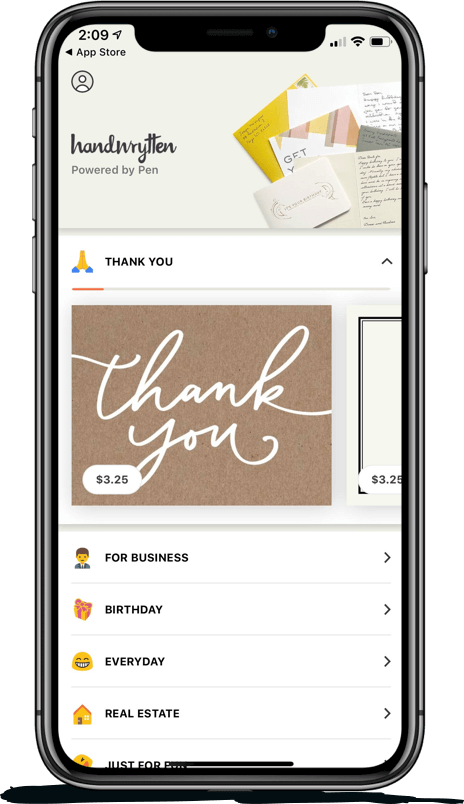
9280 S. Kyrene Rd.
Suite 134
Tempe, AZ 85284
Phone: +1 (888) 284-5197
Email: contact@handwrytten.com



You have been subscribed. Thank you!
Category: Real Estate Marketing


The real estate market has seen a seismic shift towards online marketing, leveraging platforms from social media to property web sites to email campaigns. At the same time, traditional marketing tools have been sidelined or substantially reduced. Yet, amid this digital dominance, a classic and timeless marketing tool continues to make waves: handwritten notes. These personal touches have remained a steadfast and potent tool for real estate agents looking to stand out and build genuine, lasting relationships with their clients.
For real estate professionals, integrating these tactile tokens of appreciation into their comprehensive marketing strategy not only differentiates them in a saturated market but also lays the foundation for trust, a crucial element in the home buying and selling process.
Handwritten notes, in their essence, are more than just pieces of paper with ink. They carry with them a sense of personal touch, effort, and sincerity. A report by Psychology Today suggests that receiving a handwritten note can evoke strong feelings of being valued and acknowledged, something a digital message often lacks. For real estate agents, this means building a foundation of trust and authenticity with potential clients from the get-go.
In an industry flooded with digital ads, email campaigns, and virtual tours, handwritten notes offer a refreshing break from the norm. They serve as a tangible reminder of an agent’s dedication and personal commitment to their clients. According to a blind survey Handwrytten ran with consumers, handwritten notes are the surest path to retention and referrals. This emphasizes their effectiveness in standing out in a crowded market.
While digital marketing tools offer scalability and reach, they often lack the personal touch that resonates deeply with individuals. Handwritten notes, on the other hand, fill this gap by providing a tangible connection in an increasingly virtual world. Integrating both digital and tactile marketing methods creates a well-rounded strategy that appeals to a wider audience demographic.
Marc Silver, a real estate agent from Philadelphia, seamlessly integrated handwritten notes into his digital marketing campaign. In addition to traditional digital campaigns, Marc uses handwritten notes to prospect entire neighborhoods. The result? More client prospects in this down market.
Every handwritten note should be more than just a greeting; it’s an opportunity to make a lasting impression. Essential elements include addressing the recipient by name, referencing specific interactions or properties of interest, and expressing genuine enthusiasm. By including specific personal references in your handwritten notes, you can increase your perceived authenticity even more.
Depending on where the client is in the home buying or selling process, the content of your note should differ. For instance:
For a full breakdown of possible notes, please read our article on 25 Handwrytten Notes for Real Estate Agents.
Incorporating handwritten notes into large-scale marketing campaigns might seem daunting. However, with tools like Handwrytten, agents can send authentic-looking handwritten notes at scale. These platforms use advanced technology to replicate human handwriting, ensuring each note retains its personal touch. An article from NAR magazine highlighted how automation tools have revolutionized personalized real estate marketing.
For a comprehensive strategy, it’s crucial to monitor the effectiveness of your handwritten notes. Implement systems to track responses, feedback, and subsequent client interactions. This could be as simple as a spreadsheet noting the date, recipient, and outcome of each note sent. Tracking ensures you can refine your approach and optimize for the best results.
If you are looking for other ways to track, Handwrytten can help you by including a unique URL or QR code on each note, which ties back to the individual recipient. The landing page of these notes could be a property website or the website of the REALTOR. However, just be careful: not everyone wants to scan QR codes, and might find shortened URLs to be questionable.
Handwritten notes can act as a bridge between your digital and offline marketing efforts. After sending an email newsletter or conducting a social media campaign, a follow-up handwritten note can reinforce your message and add a personal touch. This multi-channel approach ensures clients receive consistent messaging while also feeling valued on a personal level.
For events like open houses or client appreciation gatherings, handwritten notes can serve as unique invitations or thank-you messages. They add a memorable touch, increasing the likelihood of attendance and post-event engagement.
Handwrytten can assist you with automating your birthday and “Homiversary” cards. Simply upload a list of your contacts and their birthdays or home purchase dates, and we can ensure each contact is sent an authentic handwritten card (and potentially gift card) every year, totally removing it from your plate. We can even include a business card or “I’m never too busy for your referrals” sticker.
It’s essential to track the tangible results of your handwritten note campaigns. This includes metrics like increased sales, higher client retention rates, and a boost in referrals. By comparing these figures with periods where handwritten notes weren’t utilized, you can get a clear picture of their impact.
Beyond numbers, gather feedback from clients and recipients of your notes. Did they appreciate the gesture? Did it influence their decision to work with you? Such insights can offer valuable information on refining your approach for even better results.
Real estate professionals across the globe are harnessing the unmatched power of handwritten notes to connect with clients.
Ben Graham, leader of the Graham Group Real Estate at Infinity & Associates Real Estate in Chandler, AZ shares his experience, “Many times, I get notes that tell me I was the only one that actually sent them a birthday card.” Such firsthand accounts from agents highlight the effectiveness and unparalleled impact of handwritten notes in building lasting relationships in the real estate industry.
Stacy Staub, the co-founder and CEO of West + Maine Homes in Denver says handwritten notes are embedded in the company culture. She encourages the 500 agents she manages to write two notes a day to their clients and colleagues. The brokerage stocks a variety of cards and envelopes in each office and regularly rotates in new selections. They even have training events centered on the subject.
As the real estate landscape evolves with technological advancements, there remains an irreplaceable charm in traditional marketing tools like handwritten notes. In the vast sea of digital communications, these notes emerge as islands of personal connection, making clients feel seen, acknowledged, and valued. They bridge the gap between the efficiency of modern technology and the warmth of human touch. For real estate agents striving to make a mark, blending the age-old tradition of handwritten notes with contemporary marketing strategies can pave the way for unparalleled success and client satisfaction.
In an era dominated by digital marketing, handwritten notes offer a unique and personal touch in the real estate industry. These notes build trust, differentiate agents in a competitive market, and seamlessly integrate with modern marketing strategies. Studies and testimonials underscore their effectiveness in enhancing client relationships and boosting sales. As the real estate landscape evolves, blending traditional tools like handwritten notes with contemporary methods can lead to unparalleled success.
If you would like us to assist implementing a cohesive handwritten card program in your business, please reach out to us and we would be happy to assist, or visit our page devoted to Real Estate to learn more about our best practices and features.


Scale your handwritten outreach, creating positive impressions and long lasting bond.
Sign Up Today!


Over 100 designs to choose from or design your own. Our online card customizer makes it simple.
Check Out Our Cards!





